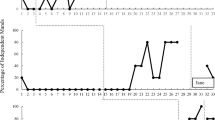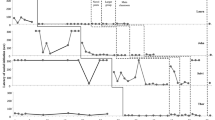Abstract
A multiple probe across participants with an embedded withdrawal single case research design was used to examine the effectiveness of a progressive time delay (PTD) procedure to teach preschoolers with disabilities to imitate their peers during a sculpting play activity. Data indicated the presence of a functional relation between the use of PTD and contingent reinforcement on increased levels of peer imitation across participants; levels also decreased when PTD was withdrawn, although not to baseline levels. Overall levels of peer imitation had a greater magnitude of change than demonstrated in previous research.

Similar content being viewed by others
References
Ayres, K., & Ledford, J. R. (2014). Dependent measures and measurement systems. In D. L. Gast & J. R. Ledford (Eds.), Single case research methodology: Applications in special education and behavioral sciences (pp. 124–153). New York: Routledge.
Bandura, A. (1977). Social learning theory. Englewood Cliffs, NJ: Prentice-Hall.
Barton, E. E. (2015). Teaching generalized pretend play and related behaviors to young children with disabilities. Exceptional Children, 81, 489–506.
Barton, E. E., & Ledford, J. R. (2018). The effects of reinforcement on peer imitation in a small group play context. Journal of Early Intervention. 40(1), 105381511774840
Carr, E. G., & Darcy, M. (1990). Setting generality of peer modeling in children with autism. Journal of Autism and Developmental Disorders, 20, 45–59.
Chazin, K. T., Ledford, J. R., Barton, E. E., & Osborne, K. C. (2017). The effects of antecedent exercise on engagement during large group activities for young children. Remedial and Special Education, 39, 158–170.
Daly, J. E., Wells, N. J., Swanger-Gagne, M. S., Carr, J. E., Kunz, G. M., & Taylor, A. M. (2009). Evaluation of the multiple-stimulus without replacement preference assessment method using activities as stimuli. Journal of Applied Behavior Analysis, 42, 563–574.
Division for Early Childhood. (2014). DEC recommended practices in early intervention/early childhood special education 2014. Retrieved from http://www.dec-sped.org/recommendedpractices.
Garfinkle, A. N., & Schwartz, I. S. (2002). Peer imitation: Increasing social interactions in children with autism and other developmental disabilities in inclusive preschool classrooms. Topics in Early Childhood Special Education, 22, 26–38.
Gazdag, G., & Warren, S. F. (2000). Effects of adult contingent imitation on development of young children’s vocal imitation. Journal of Early Intervention, 23, 24–35.
Hixson, M. D. (2004). Behavioral cusps, basic behavioral repertoires, and cumulative-hierarchical learning. The Psychological Record, 54, 387–403.
Hume, K., Loftin, R., & Lantz, J. (2009). Increasing independence in autism spectrum disorders: A review of three focused interventions. Journal of Autism and Developmental Disorders, 39, 1329–1338.
Hwang, B., & Hughes, C. (1995). Effects of social interactive strategies on early social-communicative skills of a preschool child with developmental disabilities. Education and Training in Mental Retardation and Developmental Disabilities, 30, 336–349.
Hwang, B., & Hughes, C. (2000). The effects of social interactive training on early social communicative skills of children with autism. Journal of Autism and Developmental Disorders, 30, 331–343.
Ingersoll, B. (2010). Brief report: Pilot randomized controlled trial of reciprocal imitation training for teaching elicited and spontaneous imitation to children with autism. Journal of Autism and Developmental Disorders, 40, 1154–1160.
Ingersoll, B. (2012). Brief report: Effect of a focused imitation intervention on social functioning in children with autism. Journal of Autism and Developmental Disorders, 42, 1768–1773.
Ingersoll, B., Lewis, E., & Kroman, E. (2007). Teaching the imitation and spontaneous use of descriptive gestures in young children with autism using a naturalistic behavioral intervention. Journal of Autism and Developmental Disorders, 37, 1446–1456.
Ingersoll, B., & Schreibman, L. (2006). Teaching reciprocal imitation skills to young children with autism using a naturalistic behavioral approach: Effects on language, pretend play, and joint attention. Journal of Autism and Developmental Disorders, 36, 487–505.
Lane, J. D., Gast, D. L., Shepley, C., & Ledford, J. R. (2015). Including social opportunities during small group instruction of preschool children with social-communication delays. Journal of Early Intervention, 37, 3–22.
Ledford, J. R., & Gast, D. L. (2014). Combination and other designs. In D. L. Gast & J. R. Ledford (Eds.), Single case research methodology: Applications in special education and behavioral science (pp. 346–376). New York: Routledge.
Ledford, J. R., Lane, J. D., Elam, K. L., & Wolery, M. (2012). Using response-prompting procedures during small-group direct instruction: Outcomes and procedural variations. American Journal on Intellectual and Developmental Disabilities, 117, 413–434.
Ledford, J. R., & Wolery, M. (2011). Teaching imitation to young children with disabilities: A review of the literature. Topics in Early Childhood Special Education, 30, 245–255.
Ledford, J. R., & Wolery, M. (2013). Peer modeling of academic and social behaviors during small-group direct instruction. Exceptional Children, 79, 439–458.
Ledford, J. R., & Wolery, M. (2015). Observational learning of academic and social behaviors during small-group direct instruction. Exceptional Children, 81, 272–291.
Rosales-Ruiz, J., & Baer, D. M. (1997). Behavioral cusps: A developmental and pragmatic concept for behavior analysis. Journal of Applied Behavior Analysis, 30, 533–544.
Stone, W. L., Ousley, O. Y., & Littleford, C. L. (1997). Motor imitation in young children with autism: What’s the object? Journal of Abnormal Child Psychology, 25, 475–485.
Stone, W. L., & Yoder, P. J. (2001). Predicting spoken language level in children with autism spectrum disorders. Autism, 5, 341–361.
Strain, P. S., Schwartz, I. S., & Barton, E. E. (2011). Providing interventions for young children with autism spectrum disorders: What we still need to accomplish. Journal of Early Intervention, 33, 321–332.
Tapp, J. (2003). ProcoderDV. Nashville, TN: Vanderbilt Kennedy Center.
Venn, M. L., Wolery, M., Werts, M. G., Morris, A., DeCesare, L. D., & Cuffs, M. S. (1993). Embedding instruction in art activities to teach preschoolers with disabilities to imitate their peers. Early Childhood Research Quarterly, 8, 277–294.
Wolery, M. (2013). A commentary: Single-case design technical document of the what works clearinghouse. Remedial and Special Education, 34, 39–43.
Wolery, M., Ault, M. J., & Doyle, P. M. (1992). Teaching students with moderate to severe disabilities: Use of response prompting strategies. London: Longman Publishing Group.
Acknowledgments
The authors would like to acknowledge the children, families, teachers, and staff of the Susan Gray School whose participation and support made this study possible.
Author information
Authors and Affiliations
Contributions
E. S., E. B., and J. L. conceptualized the study. E. S. wrote an initial draft. E. B. and J. L. reviewed and edited the draft.
Corresponding author
Ethics declarations
Conflict of interest
Sweeney declares that she has no conflict of interest. Barton declares that she has no conflict of interest. Ledford declares that she has no conflict of interest.
Ethical Approval
All procedures performed in studies involving human participants were in accordance with the ethical standards of the institutional research committee and with the 1964 Helsinki declaration and its later amendments.
Informed Consent
Informed consent was obtained from all individual participants included in the study.
Rights and permissions
About this article
Cite this article
Sweeney, E., Barton, E.E. & Ledford, J.R. Using Progressive Time Delay to Increase Levels of Peer Imitation During Sculpting Play. J Autism Dev Disord 53, 516–524 (2023). https://doi.org/10.1007/s10803-018-3638-2
Published:
Issue Date:
DOI: https://doi.org/10.1007/s10803-018-3638-2




